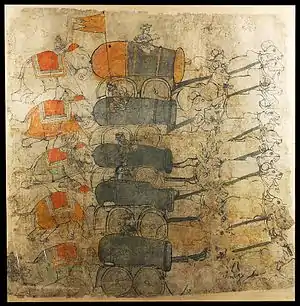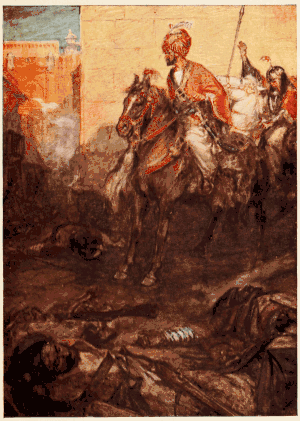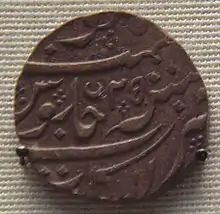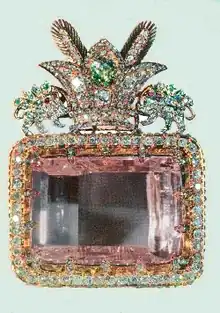Muhammad Shah
Mirza Nasir-ud-Din Muḥammad Shah (born Roshan Akhtar;[1] 7 August 1702 – 26 April 1748)[1] was the thirteenth Mughal emperor from 1719 to 1748.[4] He was son of Khujista Akhtar, the fourth son of Bahadur Shah I. After being chosen by the Sayyid Brothers of Barha, he ascended the throne at the young age of 16, under their strict supervision.[5]
| Muhammad Shah محمد شاه | |||||||||
|---|---|---|---|---|---|---|---|---|---|
| Padishah Al-Sultan Al-Azam | |||||||||
 Emperor Muhammad Shah standing in a landscape and holding a sarpech, c. 1738 | |||||||||
| 13th Mughal Emperor | |||||||||
| Reign | 27 September 1719 – 26 April 1748 | ||||||||
| Coronation | 29 September 1719 | ||||||||
| Predecessor | Shah Jahan II Jahangir II (titular) | ||||||||
| Successor | Ahmad Shah Bahadur | ||||||||
| Wazirs |
| ||||||||
| Born | Roshan Akhtar[1] 7 August 1702 Ghazni, Kabul Subah, Mughal Empire | ||||||||
| Died | 26 April 1748 (aged 45) Delhi, Mughal Empire | ||||||||
| Burial | Mausoleum of Muhammad Shah, Nizamuddin Dargah, Delhi, India | ||||||||
| Consort | |||||||||
| Wives |
| ||||||||
| Issue |
| ||||||||
| |||||||||
| House | House of Babur | ||||||||
| Dynasty | Timurid dynasty | ||||||||
| Father | Jahan Shah | ||||||||
| Mother | Fakhr-un-Nissa Begum[2] | ||||||||
| Religion | Sunni Islam (Hanafi) | ||||||||
| Mughal emperors | ||||||||||||||||||||||||||||||||||||||||||||||
|---|---|---|---|---|---|---|---|---|---|---|---|---|---|---|---|---|---|---|---|---|---|---|---|---|---|---|---|---|---|---|---|---|---|---|---|---|---|---|---|---|---|---|---|---|---|---|
|
||||||||||||||||||||||||||||||||||||||||||||||
He later got rid of them with the help of Nizam-ul-Mulk, Asaf Jah I – Syed Hussain Ali Khan was murdered at Fatehpur Sikri in 1720 and Sayyid Hassan Ali Khan Barha was captured in battle in 1720 and fatally poisoned in 1722.[6] Muhammad Shah was a great patron of the arts, including musical, cultural and administrative developments, he is thus often referred to as "Muhammad Shah Rangila" (lit. 'Muhammad Shah "the colourful"').[7] His pen-name was "Sadrang" and he is also sometimes referred to as "Bahadur Shah Rangila" after his grand father Bahadur Shah I.
Muhammad Shah's reign was marked by rapid and irreversible decline of the Mughal Empire that was exacerbated by Nader Shah's invasion of India and the sacking of Delhi in 1739. The course of events not only shocked and mortified the Mughals themselves, but also other foreigners, including the British.
Early reign
On 29 September 1719, Muhammad Shah was given the title Abu Al-Fatah Nasir-ud-Din Roshan Akhtar Muhammad Shah and enthroned in the Red Fort, succeeding Shah Jahan II. His mother was given an allowance of fifteen thousand rupees monthly for her needs, but the Sayyid Brothers kept the new emperor under strict supervision.
The Mughal Grand vizier Syed Hassan Ali Khan Barha and his brother Syed Hussain Ali Khan Barha, the commander-in-chief of the Mughal army were aware of a plot by Asaf Jah I and Zain ud-Din Ahmed Khan to remove them from the positions of influence in the Mughal court that had enjoyed since the death of emperor Aurangzeb in 1707. The brothers had arranged for Prince Muhammad Ibrahim to succeed emperor Shah Jahan II as Jahangir II. However, he was quickly defeated by Muhammad Shah loyalists in a battle near Agra on 13 November 1720 and imprisoned in Shahjahanabad.

Muhammad Shah eventually learned the skills of statesmanship after removing his three incompetent advisors, namely Koki Jee (his foster sister), Roshan-ud-Daula (his mercantile friend) and Sufi Abdul Ghafur of Thatta (his spiritual teacher).
Removing the Sayyid Brothers

On 9 October 1720, Syed Hussain Ali Khan Barha, the commander and chief of the Mughal army, was assassinated in his encampment in Todabhim and Muhammad Shah took direct command of the army. Asaf Jah I was then dispatched to gain complete control of six Mughal provinces in the Deccan, and Muhammad Amin Khan Turani was assigned as the Mansabdar of 8000. He was sent to pursue the Mughal Grand vizier Syed Hassan Ali Khan Barha, who was defeated at the battle of Hasanpur by Muhammad Amin Turani, Khan-i Dauran, Sher Afkan Panipati, and Amin-ud-Din Sambhali. Hassan Khan Barha fought on the side opposing Khan-i-Dauran where the most danger was anticipated,[8] was captured on 15 November 1720 and executed two years later. The fall of the Sayyid Brothers would mark the beginning of the end of the Mughal Empire's direct control over its dominions in the Deccan.
Loss of Deccan subahs
On 21 February 1722, Muhammad Shah appointed the Asaf Jah I as Grand Vizier. He advised Muhammad Shah to be "as cautious as Akbar and as brave as Aurangzeb". Asaf Jah used his influence with the emperor to fulfil his territorial ambitions in the Deccan. He lost the emperor's confidence when he appointed Hamid Khan, a relative to Saadullah Khan and his maternal uncle, to administer Gujarat after having sending him on the pretext of restoring order to the province.[9] Realising his loss of influence and trust from the emperor, Asaf Jah resigned as Grand Vizier and returned to the Deccan.[10]
Asaf Jah I appointed commander Ewaz Khan as the master of the garrison at Aurangabad, and much of his logistical duties were carried out by Inayatullah Kashmiri.[11] In 1723 he set out on an expedition to the Deccan, where he fought Mubariz Khan, the Mughal Subahdar of the Deccan, who had kept the ravaging Maratha Empire at bay. Mubariz Khan was a former ally of the Barha Sayyids, who was appointed by Muhammad Shah to kill Asaf Jah I.[12] Taking advantage of Mubariz Khan's conventional weaknesses, Asaf Jah I defeated and eliminated his opponent during the Battle of Shakar Kheda. Asaf Jah I then established the Hyderabad State and appointed himself the Nizam of Hyderabad in 1725.
The Mughal-Maratha Wars (1728–1763)[13] would cause irreparable devastation to six Deccan subahs–Khandesh, Bijapur, Berar, Aurangabad, Hyderabad and Bidar. Asaf Jah would the Marathas to invade Malwa and the northern territories of the Mughal empire to protect his newfound independence.[14][15][16] The Nizam described the Maratha army to be an instrument to be wielded to his own advantage in the Maasir-i Nizami:[17]
"I consider all this army (Marathas) as my own and I will get my work done through them. It is necessary to take our hands off Malwa. God willing, I will enter into an understanding with them and entrust the Mulukgiri (raiding) on that side of the Narmada to them."
The ears of the Muhammed Shah were possessed by the Amir-ul-Umara, Khan-i Dauran.[18] Muhammad Shah appointed Qamar-ud-Din Khan as Grand Wazir to succeed Asaf Jah. However, he was quickly dismissed in favour of Roshan-ud-Daulah Turrah Baz Khan, a native of Panipat,[19] who was appointed the Grand Wazir, in order to reduce the influence of the Turani family.[20]
Despite the loss of the Deccan subahs in 1724, the Nawab of Awadh Saadat Ali Khan and the Mughal subahdar Dilawar Khan (r.1726–1756) remained loyal to the emperor and established a well-protected bastion on the Malabar Coast.
Cultural developments



While Urdu (derived from Zuban-i Urdū-yi Muʿallá or in local translation Lashkari Zaban, shortened to Lashkari) was already in use before Muhammad Shah's reign, it was during his reign that it became more popular among the people and he declared it as the court language, replacing Persian. During Muhammad Shah's reign, Qawwali was reintroduced into the Mughal imperial court and it quickly spread throughout South Asia. Muhammad Shah is also known to have introduced religious institutions for education such as Maktabs. During his reign, the Quran was translated for the first time into simple Persian and Urdu. Also, during his reign, the formal Turkic dress, normally worn by the high Mughal nobility since Mughals originally hailed from Samarqand, was replaced by the Sherwani. However, Muhammad Shah's adoption of the Deccan-influenced dress to court would lead to derisive comments, such as "See how the Deccan monkey dances!"[21][22]
Mohammad Shah was a patron of the performing arts, almost at the cost of administrative priorities, paving the way for the disintegration of governance. While Mughal political power did decline in his reign, the Emperor encouraged the arts, employing master artists such as Nidha Mal (active 1735–75) and Chitarman, whose vivacious paintings depict scenes of court life, such as Holi celebrations, hunting and hawking.[23] The Mughal court of the time had musicians such as Naimat Khan, also known as Sadarang, and his nephew Firoz Khan (Adarang), whose compositions popularised the musical form of khyal. Naimat Khan composed khyal for his disciples and he never performed khyal.[24] This key component of Indian classical music evolved, ascended and received princely patronage at the court of Muhammad Shah.[25]
He himself was a poet under the penname "Sadrang" and was also a composer of Indian classical raga songs in the bhairav, kafi, dhamar and malkauns genres. These included songs on the themes of love and the festival of Holi.[7]
Scientific developments
During the reign of Muhammad Shah, a significant scientific work known as the Zij-i Muhammad Shahi was completed by Jai Singh II of Amber between the year 1727 and 1735; it consisted of 400 pages.[26]
Bengal and Sikhs raids
Muhammad Ali Khan the Mughal Faujdar of Rangpur and his stern ally Deena Narayan were ambushed out of Koch Bihar by Upendra Narayan a Hindu Bihari and Mipham Wangpo (r.1729–1736) the ruler of Bhutan. Ali Mohammed Khan had established the barons of Rohilakhand. In the Punjab region, the Sikhs were at war with local Mughal subahdars, devastating them with their hit-and-run tactics.
Loss of Gujarat and Malwa subahs
In Ajmer, Ajit Singh carved out a vast territory and allied himself with the Marathas. The Marathas, who had already expanded up to the Narmada river, invaded Malwa in early 1723 and reached its capital Ujjain by the winter. In 1725, Sarbuland Khan was appointed the subah of Gujarat. Enraged by the attempt of the Mughal emperor to exert his authority, the Marathas invaded Gujarat but their secondary force was routed by Sarbuland Khan and his forces. The main Maratha force, including Peshwa Bajirao I, were fighting Asaf Jah I in Hyderabad.
After decisively defeating Asaf Jah in February 1728 at the Battle of Palkhed, Bajirao I and his brother Chimaji Appa re-invaded Malwa. The Mughal subahdar Giridhar Bahadur was defeated and killed at the battle of Amjhera in November 1729.[27] Chimnaji Appa then unsuccessfully attempted to besiege the remnants of the Mughal army at Ujjain.[28]

In 1731, Asaf Jah managed to secure the defections of influential Maratha leaders, such as Trimbak Rao Dabhade and Sanbhoji who threatened to abandon the Marathas and join the forces with the emperor Muhammad Shah. However, the defectors were overrun and killed by a large Maratha force led by Bajirao I and Chimnaji Appa during Battle of Dabhoi.[28] Bajirao I then attacked Gujarat with his full force and drove out Sarbuland Khan by 1735.

On 19 April 1736, the Siddis of Murud-Janjira set out to recapture Raigad Fort from the forces of Bajirao. Chimaji Appa attacked the encampments of the gathering forces near Riwas, killing 1,500, including their leader Siddi Sat. Peace was concluded in September 1736, with the Siddis confined to Janjira, Gowalkot and Anjanvel.
In 1737, Asaf Jah I led a large Mughal army to assist the Nawab of Bhopal Yar Muhammad Khan Bahadur but was instead besieged inside the city of Bhopal by 80,000 Marathas led by Bajirao I. The Battle of Bhopal continued until Safdar Jang and his relief forces were driven away by Malhar Rao Holkar. The Marathas annexed Gujarat, Malwa and Bundelkhand, and raided the Mughal capital Delhi.
Bajirao I defeated a well-trained Mughal army led by Amir Khan Bahadur, but was forced to withdraw when well-armed Mughal reinforcements fought major skirmishes with the Marathas on the outskirts of Delhi. Bajirao and his Marathas fled southeast to Badshahpur, where he corresponded with the emperor Muhammad Shah, who ratified peace by agreeing the handover of Malwa to the Marathas.[28]
Invasion of Nader Shah
Nader Shah, the Afsharid Shah of Iran had deposed the Safavid dynasty in 1736. He quickly moved to secure his Persian borders with the Ottoman Empire and engineered an alliance with the Russian Empire and secured the removal of Russian troops from Persian territory. He conquered Kandahar in 1738 and turned his attention to the still wealthy but weak Mughal empire.
Pretext for invasion
Nader Shah used the pretext of the Mughal empire sheltering his Afghan enemies, particularly the Ghilzai tribe, in the region around Kandahar.[30] and demanded that emperor Muhammad Shah close his frontiers around Kabul and the Indus Valley so that the rebels may not flee or seek refuge. Muhammad Shah gave a confirming reply to Nader Shah but did not take any action because the local subahdars and faujdars were sympathetic to the Afghans and rejected Persian rule. The Afghan rebels would eventually flee into the Mughal empire. Outraged by this, Nader Shah sent an ambassador to Muhammad Shah, demanding deliverance of the fugitives. The Mughal emperor did not provide a positive response and kept the Persians marginalised from Delhi for an entire year.
Invasion of Mughal empire
In May 1738, Nader Shah attacked northern Afghanistan and captured Ghazni. He captured Kabul in June and Jalalabad in September. By November, he had crossed the Khyber Pass and besieged and razed the fortress of Peshawar. In January 1739, he captured Lahore, after completely subduing the forces of the Mughal viceroy, Zakariya Khan Bahadur and his 25,000 sowars,[31] by the Chenab river. The Afsharid forces soon encountered bands of Sikh rebels whom Nader Shah predicted would clearly benefit after his invasion.[31] The Afsharids would capture territory all the way up to Attock, forcing Muhammad Shah and his court to realise that the Persian emperor would not be satisfied with the loot of a province. The cities of Wazirabad, Eminabad and Gujrat were not only sacked but razed to the ground. Near Larkana, the Afsharids completely routed the Mughal army of the Nawab of Sindh, Main Noor Mohammad Kalhoro, and later captured him and his two sons. Sirhind was then captured by the Persians in February 1739, opening the route towards the Mughal capital of Delhi.
Battle of Karnal
Nader Shah decisively defeated a 100,000-strong Mughal army with only 55,000 men in less than three hours at the Battle of Karnal. Mughal commander-in-chief Khan Dowran VII was killed in the battle, writing in his will that the Mughal and Afsharid emperors should not meet and that Nader Shah should be turned away at all costs.


Rao Bal Kishan of Rewari, with his army of 5,000 infantry and 2,000 cavalry and with the forces of Delhi, attempted a desperate defence of the city but was killed in battle and has been immortalized the name "Vijay or "Veergati". Nadir Shah remarked to emperor Muhammad Shah that "if your combined forces helped Rao Balkrishna of Rewari, then I might not able to enter in Delhi. I had never seen any warrior like him brave, Fierce and strong. Muhammed Shah commissioned a royal chhatri to pay tribute to Rao Bal Kishan.[32][33][34]
Muhammad Shah surrendered to Nader Shah on 26 February in the Afsharid encampments, thirteen days after the battle of Karnal. Handing over the keys of the Delhi Gate, he was marched as a captive by Nader Shah to the city, which was then completely plundered.
After entering Delhi, Nader Shah claimed to invasion and occupation of the Mughal Empire was borne out of religious devotion and that if "the wretched Marathas of the Deccan" moved towards Delhi, he might "send an army of victorious Qizilbash to drive them to the abyss of Hell."[35][36]
Sack of Delhi


The occupation of Delhi was initially cordial, however, rumours spread throughout the city that Nader Shah was assassinated. The masses attacked the Persian force and killed some soldiers. Nader Shah, furious, ordered to massacre the populace, and leaving at least 30,000 dead. Muhammad Shah and Asaf Jah I had to beg Nader Shah for mercy and thus he stopped the massacre and turned to looting the Mughal treasury.[37] The famous Peacock Throne, the Daria-i-Noor and Koh-i-Noor diamonds and unimaginable wealth was looted. In addition, elephants, horses and everything that was liked was taken. Muhammad Shah also had to hand over his daughter Jahan Afruz Banu Begum as a bride for Nader Shah's youngest son. Asaf Jah I retired to Deccan after installing his eldest son Intizam-ud-Daula as a major commander in the Mughal Army.[38]
After the whole event, Muhammad Shah was crowned as emperor by Nader Shah himself on 12 May, and ceding the area west of river Indus to Nader Shah, although the Kalhora Nawabs of Sindh continued to fight the invading Afsharids. Nader Shah and his forces then started to return to Persia.
Aftermath
The Mughal empire rapidly disintegrated after the invasion. The weak Mughal army was no match to the Sikh and Maratha forces, with rebellions becoming commonplace.
Later Maratha wars
In the year 1740, Dost Ali Khan to Nawab of the Carnatic and Chanda Sahib faced the task of expelling the Marathas under Raghoji I Bhonsle, authorised by Chhatrapati Shahu I. Dost Ali Khan was killed on 20 May 1740 at the Battle of Damalcherry in defence of Arcot, which was eventually looted and plundered. Chanda Sahib along with his garrison was captured and imprisoned in Satara. Chanda Sahib and his forces ferociously defended their rightful reams during the Siege of Trichinopoly and almost all the territories of the Nawab of the Carnatic despite being outnumbered substantially by the Marathas, their daunting efforts soon attracted the attention of the French East India Company official Joseph François Dupleix.[39]
Dissatisfied by the Maratha occupation of the territories of the Nawab of the Carnatic, Asaf Jah I led an expedition to liberate the region. He was joined by Sadatullah Khan II and Anwaruddin Muhammed Khan together they recaptured Arcot and initiated the Siege of Trichinopoly (1743), which lasted five months and forced the Marathas led by Murari Rao Ghorpade to evacuate the Carnatic.[39]
In the year 1747, the Marathas led by Raghoji I Bhonsle, began to raid, pillage and annex the territories of the Nawab of Bengal Alivardi Khan. During the Maratha invasion of Orissa, its subahdar Mir Jafar completely withdrew all forces until the arrival of Alivardi Khan and the Mughal Army at the Battle of Burdwan where Raghoji I Bhonsle and his Maratha forces were completely routed. The enraged Nawab of Bengal Alivardi Khan then dismissed the shamed Mir Jafar. However, four years later, emperor Muhammad Shah ceded Orissa was ceded over to the Marathas.[28]
1748 Afghan invasion
In 1748, Ahmad Shah Durrani of Afghanistan invaded the Mughal Empire. Heir-apparent Ahmad Shah Bahadur, Grand Vizier Qamaruddin Khan and his son Moin-ul-Mulk better known as Mir Mannu, Intizam-ud-Daula and Safdar Jang were sent with 75,000 men after the defeat of Shahnawaz Khan in Lahore. At the Battle of Manupur, Durrani's 12,000 men were defeated, and he was forced to retreat.
Foreign relations
Following Nader Shah's invasion, the Ottoman Empire exploited the void that was created at their eastern borders as almost all Persian forces were deployed to India. During that period, emperor Muhammad Shah tried to recover all territory until being attacked by the Durrani Empire at Battle of Manupur.[30]
Marriages

Emperor Muhammad Shah had four wives. His first wife and chief consort was his first-cousin, Princess Badshah Begum, the daughter of Emperor Farrukhsiyar and his first wife, Gauhar-un-Nissa Begum.[40] They married after his accession, on 8 December 1721, at Delhi,[41] and he gave her the title Malika-uz-Zamani (Queen of the Age)[2] by which she was popularly known. They had a son, Shahriyar Shah Bahadur, who died young in 1726.[2] She died on 14 December 1789.
Muhammad Shah took a second wife, Sahiba Mahal, and had a daughter Hazrat Begum, who was married to Ahmad Shah Durrani in 1757.[42]
His third wife was a dancing girl, Udham Bai, who bore him his successor, Ahmad Shah Bahadur on 23 December 1725. Upon his birth, he was taken from her and was lovingly brought up by Badshah Begum, who considered him her own son. It was through Badshah Begum's efforts that Ahmad Shah was able to ascend the throne upon Muhammad Shah's death in 1748.[43]
Death

The victory of the Mughal Army during the Battle of Manupur (1748) came with a heavy price as many fell in battle. Initially this was kept a secret. However, when the news reached the Mughal Emperor Muhammad Shah, he could not speak, suddenly became sick, and did not come out of his apartments for three days. During this period he fasted. His guards could hear him crying out loud and saying: "How could I bring about anyone as faithful as he? (Qamaruddin Khan)". He died due to grief on 26 April 1748, his funeral was attended by visiting Imams from Mecca.[44][45] Muhammad Shah's tomb is located in an enclosure within the Nizamuddin Dargah complex.[46]
In popular culture
- In the 2010 historical TV series Maharaja Ranjit Singh telecasted on DD National, the character of Muhammad Shah is portrayed by Rishikesh Sharma.
Gallery
 A silver coin minted during the reign of the Mughal Emperor Muhammad Shah.
A silver coin minted during the reign of the Mughal Emperor Muhammad Shah. A silver coin minted during the reign of the Mughal Emperor Muhammad Shah from Bombay.
A silver coin minted during the reign of the Mughal Emperor Muhammad Shah from Bombay._In_the_name_of_the_Mughal_emperor_Muhammad_Shah._Sawau_Jaipur_mint._Dually_dated_AH_1157_and_RY_27_of_Muhammad_Shah_(AD_1744-5).jpg.webp) Coinage of Jaipur from the time of Ishvari Singh, in the name of Muhammad Shah. Sawau Jaipur mint, dated 1744-5 CE.
Coinage of Jaipur from the time of Ishvari Singh, in the name of Muhammad Shah. Sawau Jaipur mint, dated 1744-5 CE. French-issued rupee in the name of Muhammad Shah (1719-1748) for Northern India trade, cast in Pondichéry.
French-issued rupee in the name of Muhammad Shah (1719-1748) for Northern India trade, cast in Pondichéry.
 Darya-e-Noor
Darya-e-Noor
See also
References
- "Muhammad Shah". Encyclopedia Britannica. Retrieved 18 September 2017.
- Malik, Zahir Uddin (1977). The reign of Muhammad Shah, 1719-1748. London: Asia Pub. House. p. 407. ISBN 9780210405987.
- William Irvine. Later Mughals: 1719-1739, Volume 2. p. 271.
- Sen, Sailendra (2013). A Textbook of Medieval Indian History. Primus Books. p. 193. ISBN 978-9-38060-734-4.
- Krishna (2022). The Wonder That Is Urdu. Motilal Banarsidass. p. 121. ISBN 9788120843011.
- Shaharyar M. Khan (2000). The Begums of Bhopal (illustrated ed.). I.B.Tauris. p. 18. ISBN 978-1-86064-528-0.
- Muhammad Shah Rangila. Sufinama.
- William Irvine (1971). Later Mughal. Atlantic Publishers & Distri. p. 82.
- Jaswant Lal Mehta (2005). Advanced Study in the History of Modern India 1707-1813. New Dawn Press, Incorporated. p. 145. ISBN 9781932705546.
- Ronald Vivian Smith (2005). The Delhi that No-one Knows. DC Publishers. p. 60.
- Mehta, J.L. (2005). Advanced Study in the History of Modern India 1707-1813. New Dawn Press, Incorporated. ISBN 9781932705546.
- A New Look at Modern Indian History (From 1707 to The Modern Times), 32e. S Chand Limited. 2018. p. 6. ISBN 9789352534340.
- Tony Jaques (2007). Dictionary of Battles and Sieges: A-E. Dictionary of Battles and Sieges: A Guide to 8,500 Battles from Antiquity Through the Twenty-first Century. Vol. 1. Greenwood Publishing Group. p. xxxix. ISBN 978-0313335372.
- Annals of the Bhandarkar Oriental Research Institute, Poona: Volumes 51-53. Bhandarkar Oriental Research Institute. 1970. p. 94.
The Mughal court was hostile to Nizam-ul-Mulk. If it had the power, it would have crushed him. To save himself from the hostile intentions of the Emperor, the Nizam did not interfere with the Maratha activities in Malwa and Gujarat. As revealed in the anecdotes narrated b Lala Mansaram, the Nizam-ul-Mulk considered the Maratha army operating in Malwa and Gujarat as his own
- The New Cambridge Modern History. University Press. 1957. p. 549.
- Shripid Rama Sharma (1934). Mughal Empire in India, 1526-1761: Volume 3. Karnatak Printing Press.
- Richard M. Eaton (2013). Expanding Frontiers in South Asian and World History Essays in Honour of John F. Richards. Cambridge University Press. p. 21.
- William Irvine (1971). Later Mughals. Atlantic Publishers & Distri. p. 336.
- V D. MAHAJAN (2020). Modern Indian History. Publisher:S CHAND & Company Limited. p. 13. ISBN 9789352836192.
- Jagadish Narayan Sarkar (1976). A Study of Eighteenth Century India: Political history, 1707-1761. the University of Virginia. p. 31.
- Notes on Punjab and Mughal India: Selections from Journal of the Punjab Historical Society. Sang-e-Meel Publications. 1988. p. 381.
- Ishwari Prasad (1940). A New History of India. Indian Press, Limited. p. 334.
- Princes and Painters in Mughal Delhi, 1707–1857, Asia Society exhibition
- Susheela Misra (1991). Musical Heritage of Lucknow. Harman Publishing House.
- The life of music in north India: the organization of an artistic tradition, Daniel M. Neuman
- Pollock, Sheldon (14 March 2011). Forms of Knowledge in Early Modern Asia: Explorations in the Intellectual History of India and Tibet, 1500–1800. Duke University Press. ISBN 978-0822349044 – via Google Books.
- Singh, Raghubir (1947). "Fresh Light on the Battle of Amjhera: November 29, 1729". Proceedings of the Indian History Congress. 10: 375–386. ISSN 2249-1937. JSTOR 44137163.
- Jaques, T. (2007). Dictionary of Battles and Sieges: A-E. Greenwood Press. ISBN 9780313335372.
- "Elephants pushing cannons drawn by bullocks, Kota". Archived from the original on 23 December 2014. Retrieved 24 September 2014.
- Farooqi, Naimur Rahman (1989). Mughal-Ottoman relations: a study of political & diplomatic relations between Mughal Empire and the Ottoman Empire, 1556–1748. Idarah-i Adabiyat-i Delli. ASIN: B0006ETWB8. See Google Books search.
- Chhabra, G.S. (2005). Advance Study in the History of Modern India (Volume-1: 1707-1803). Lotus Press. ISBN 9788189093068.
- Rao Bal Kishan, with his army and with the forces of Delhi, fought Nadir Shah. His army included 5000 infantry and 2000 cavalry. Rao Bal Kishan was killed in the battle but immortalized the name "Vijay or Veergati" The Battle was ambitious as Nadir Shah itself remarked to Mughal Emperor that if your combined forces helped Rao Balkrishna of Rewari, than I might not able to enter in Delhi. I had never seen any warrior like him brave, Fierce and strong. After this to a royal chhatri kiosk was made by Mughal Emperor to remark tribute to Rao Balkrishna. Today also the Chhatri is present in Karnal.
- Realm and Region in Traditional India. Duke University, Program in Comparative Studies on Southern Asia. 1977. ISBN 9780916994129.
- Haryana Digdarshan. Arihant Publications India limited. 21 February 2021. ISBN 9789325294486.
- Frances Pritchett. "part2_19". columbia.edu. Retrieved 17 January 2014.
- Muhammad Latif, The History of the Panjab (Calcutta, 1891), p. 200.
- Jagmohan (2005). Soul and Structure of Governance in India. Allied Publishers. ISBN 9788177648317. Retrieved 26 May 2014.
- H. G. Keene (1866). Moghul Empire. Allen &co Waterloo Place Pall Mall. Digital Library of India Archived 21 July 2013 at the Wayback Machine Accessed 7 January 2012
- Jaques, T. (2007). Dictionary of Battles and Sieges: P-Z. Greenwood Press. ISBN 9780313335396.
- Sarkar, Jadunath (1997). Fall of the Mughal Empire (4th ed.). Hyderabad: Orient Longman. p. 169. ISBN 9788125011491.
- Awrangābādī, Shāhnavāz Khān; Prashad, Baini; Shāhnavāz, ʻAbd al-Ḥayy ibn (1979). The Maāthir-ul-umarā: being biographies of the Muḥammadan and Hindu officers of the Timurid sovereigns of India from 1500 to about 1780 A.D. Janaki Prakashan. p. 652.
- Hoiberg, D.; Ramchandani, I. (2000). Students' Britannica India. Encyclopædia Britannica (India). ISBN 9780852297605.
- Latif, Bilkees I. (2010). Forgotten. Penguin Books. p. 49. ISBN 9780143064541.
- name="Mughal-Ottoman relations Sharif of Mecca"
- Farooqi, N.R. (1989). Mughal-Ottoman relations: a study of political & diplomatic relations between Mughal India and the Ottoman Empire, 1556-1748. Idarah-i Adabiyat-i Delli.
- Dadlani, Chanchal B. (2018). From stone to paper : architecture as history in the late Mughal Empire. New Haven [CT]. pp. 67–68. ISBN 978-0-300-23317-9. OCLC 1024165136.
{{cite book}}: CS1 maint: location missing publisher (link)
External links
 Media related to Muhammad Shah at Wikimedia Commons
Media related to Muhammad Shah at Wikimedia Commons Quotations related to Muhammad Shah at Wikiquote
Quotations related to Muhammad Shah at Wikiquote- Poetry of Muhammad Shah Rangila at Sufinama.org
- Haryana Digdarshan. Arihant Publications India limited. 21 February 2021. ISBN 9789325294486.